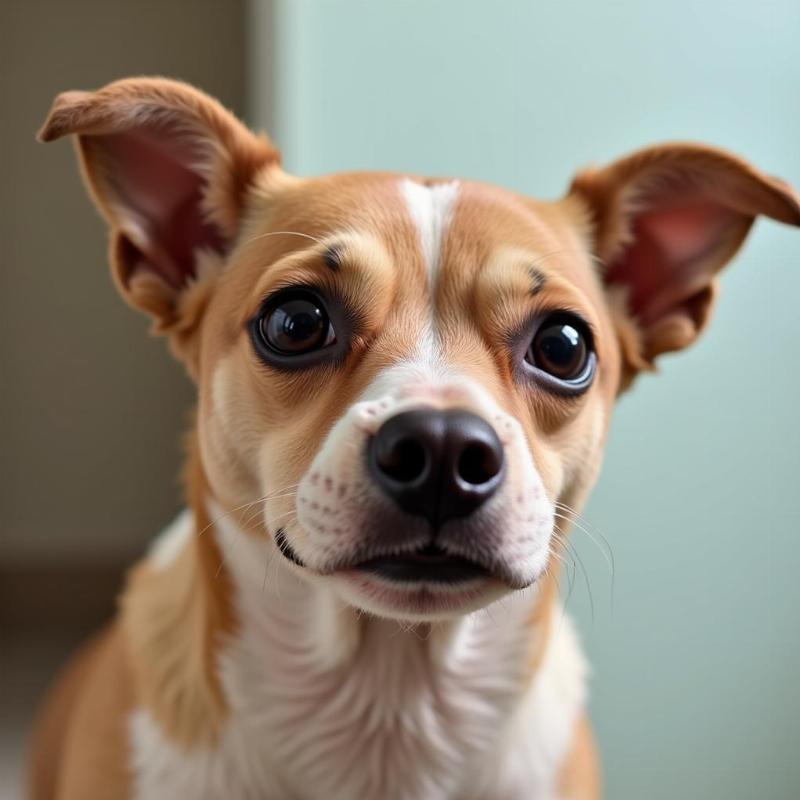The pungent aroma of fresh paint might be satisfying to us, signaling a home refresh, but for our canine companions, it can be a different story. Is paint smell bad for dogs? Yes, generally speaking, many common household paints emit volatile organic compounds (VOCs) that can irritate a dog’s respiratory system and cause discomfort. Understanding the potential dangers and taking preventive measures is crucial for keeping our furry friends safe during home improvement projects.
The Dangers of Paint Fumes for Dogs
While a quick sniff might not cause lasting harm, prolonged exposure to paint fumes, especially in poorly ventilated areas, can pose serious health risks to dogs. Their heightened sense of smell makes them even more susceptible to the irritating effects of VOCs. Symptoms of paint fume exposure in dogs can range from mild sneezing and coughing to more serious issues like vomiting, loss of coordination, and even respiratory distress.
- Respiratory Irritation: The most common reaction to paint fumes is respiratory irritation. This can manifest as coughing, wheezing, sneezing, and difficulty breathing. Smaller breeds and puppies with underdeveloped respiratory systems are particularly vulnerable.
- Eye Irritation: VOCs can also irritate a dog’s eyes, causing redness, watering, and squinting.
- Gastrointestinal Upset: If a dog ingests paint, either by licking freshly painted surfaces or consuming paint chips, it can lead to vomiting, diarrhea, and loss of appetite.
- Neurological Effects: In severe cases, prolonged exposure to high concentrations of VOCs can affect the nervous system, causing lethargy, tremors, and disorientation.
 Dog Sensitive to Paint Fumes
Dog Sensitive to Paint Fumes
Types of Paint and Their Risks
Different types of paint pose varying levels of risk to dogs. Oil-based paints typically contain higher levels of VOCs and take longer to dry, increasing the duration of exposure. Latex paints, while generally considered safer, still emit VOCs and should be used with caution around pets.
- Oil-Based Paints: These paints emit strong fumes and should be avoided completely around dogs. Their strong odor and slow drying time significantly increase the risk of exposure and subsequent health problems.
- Latex Paints: While lower in VOCs than oil-based paints, latex paints can still irritate dogs. Opt for low-VOC or zero-VOC latex paints whenever possible.
- Water-Based Paints: These are generally the safest option for pets, as they contain minimal VOCs and dry quickly. Look for paints specifically labeled as pet-friendly.
Protecting Your Dog During Painting Projects
Keeping your dog safe during painting projects requires proactive measures. Proper ventilation is essential to minimize the concentration of VOCs in the air. Keeping your dog away from the painting area and ensuring they don’t have access to paint cans or freshly painted surfaces is crucial.
- Ventilation: Open windows and doors to ensure adequate airflow. Use fans to circulate the air and help dissipate fumes.
- Confinement: Keep your dog in a separate, well-ventilated area, preferably away from the house, while painting is underway.
- Clean Up: Ensure all paint cans, brushes, and rollers are properly stored and out of reach. Clean up any spills immediately.
- Supervision: Never leave your dog unattended in an area where paint is being used or drying.
What to Do if Your Dog Is Exposed to Paint Fumes
If your dog exhibits any symptoms of paint fume exposure, such as coughing, sneezing, or vomiting, move them to a well-ventilated area immediately. Contact your veterinarian or the ASPCA Animal Poison Control Center for guidance.
“Early intervention is key when dealing with potential paint fume exposure in dogs,” says Dr. Emily Carter, DVM, a veterinary toxicologist. “Even seemingly mild symptoms can escalate quickly, so it’s always best to err on the side of caution and seek professional advice.”
Conclusion
Protecting our furry friends from the potential hazards of paint fumes requires awareness and proactive measures. By understanding the risks, choosing safer paint options, and taking appropriate precautions, we can ensure our dogs remain safe and healthy during home improvement projects. Remember, a well-ventilated space and a dog-free zone are the best ways to minimize exposure and potential health issues. Is paint smell bad for dogs? Yes, and taking these precautions will protect your beloved canine companion.
FAQ
- What are the signs of paint fume poisoning in dogs? Common signs include coughing, sneezing, wheezing, eye irritation, vomiting, and lethargy.
- What type of paint is safest for dogs? Water-based, low-VOC, or zero-VOC paints are the safest options.
- How long should I keep my dog away from freshly painted areas? At least until the paint is completely dry and the fumes have dissipated, which can take several days.
- What should I do if my dog ingests paint? Contact your veterinarian or the ASPCA Animal Poison Control Center immediately.
- Can I use air fresheners to mask the paint smell? No, air fresheners can further irritate a dog’s respiratory system. Focus on ventilation instead.
- Are there any specific breeds more susceptible to paint fumes? Brachycephalic breeds (like Bulldogs and Pugs) and puppies are more vulnerable due to their smaller airways.
- Can paint fumes affect a dog’s long-term health? Prolonged or repeated exposure to high concentrations of VOCs can potentially lead to chronic respiratory problems.
Beautdogs.us is your trusted source for comprehensive and engaging information on dog care and companionship in the US. We provide expert advice on dog breeds, grooming, nutrition, and training, catering to both new and experienced dog owners. Explore our website for valuable resources, product reviews, and the latest trends in pet care. Contact us today for personalized support and guidance! Email: [email protected], Phone: +1 501-555-7529. Visit Beautdogs.us, your one-stop destination for all things dog!